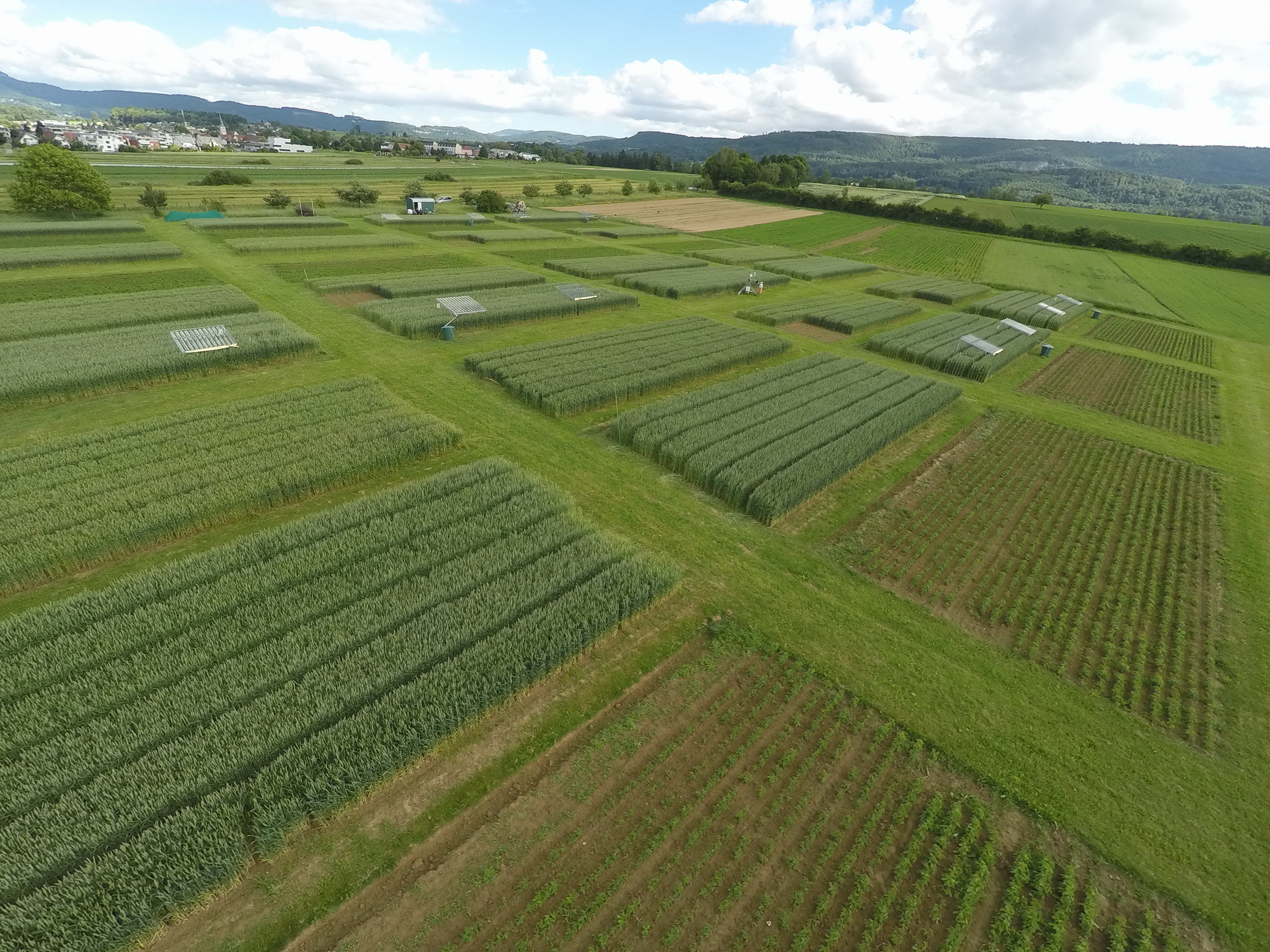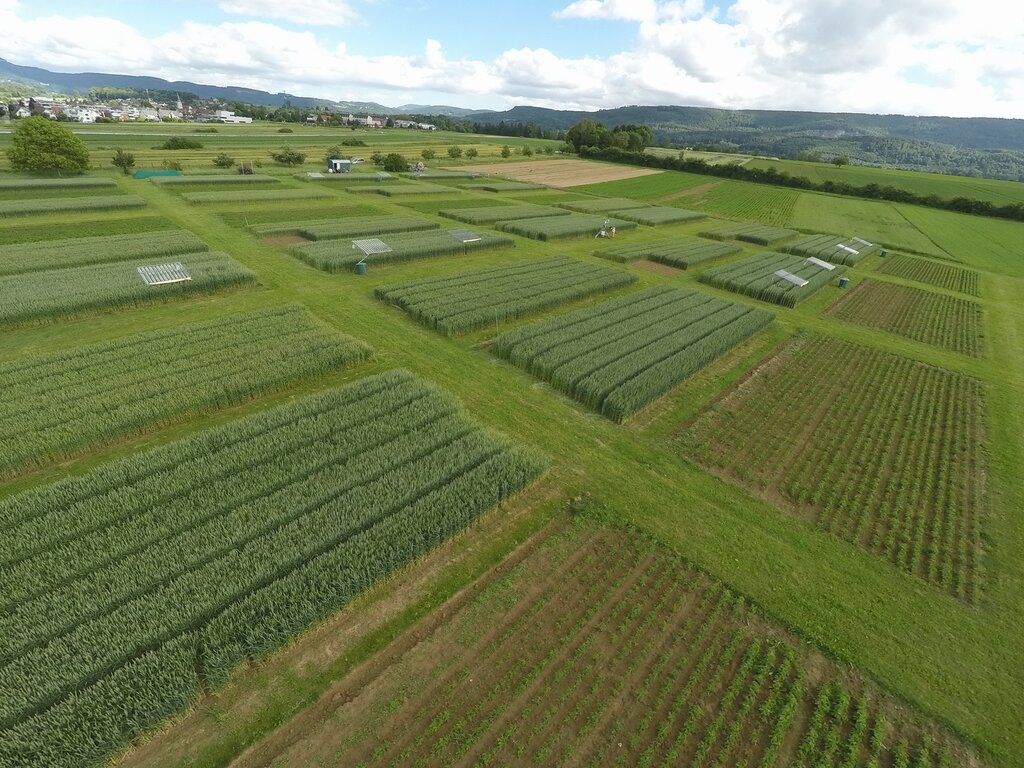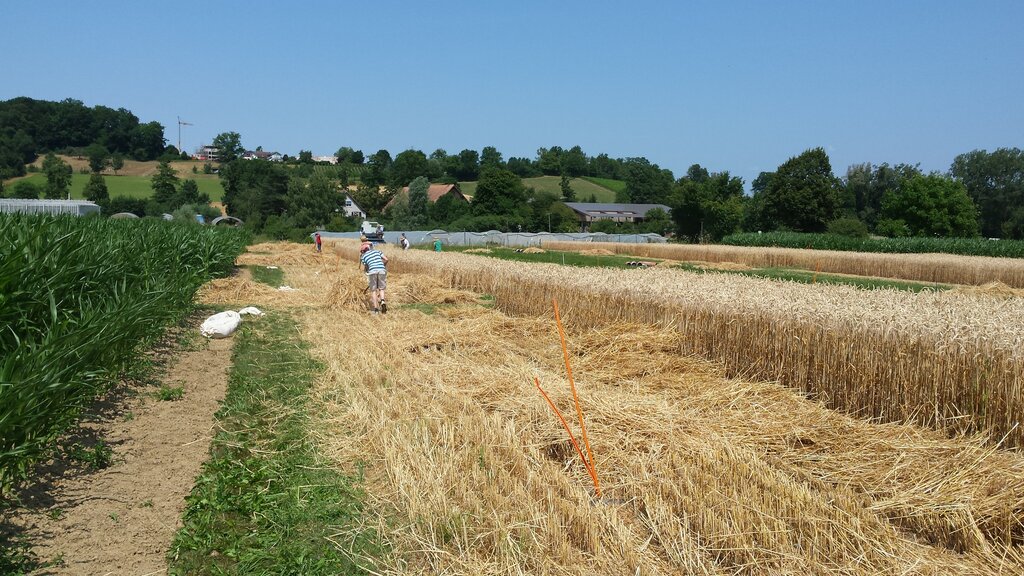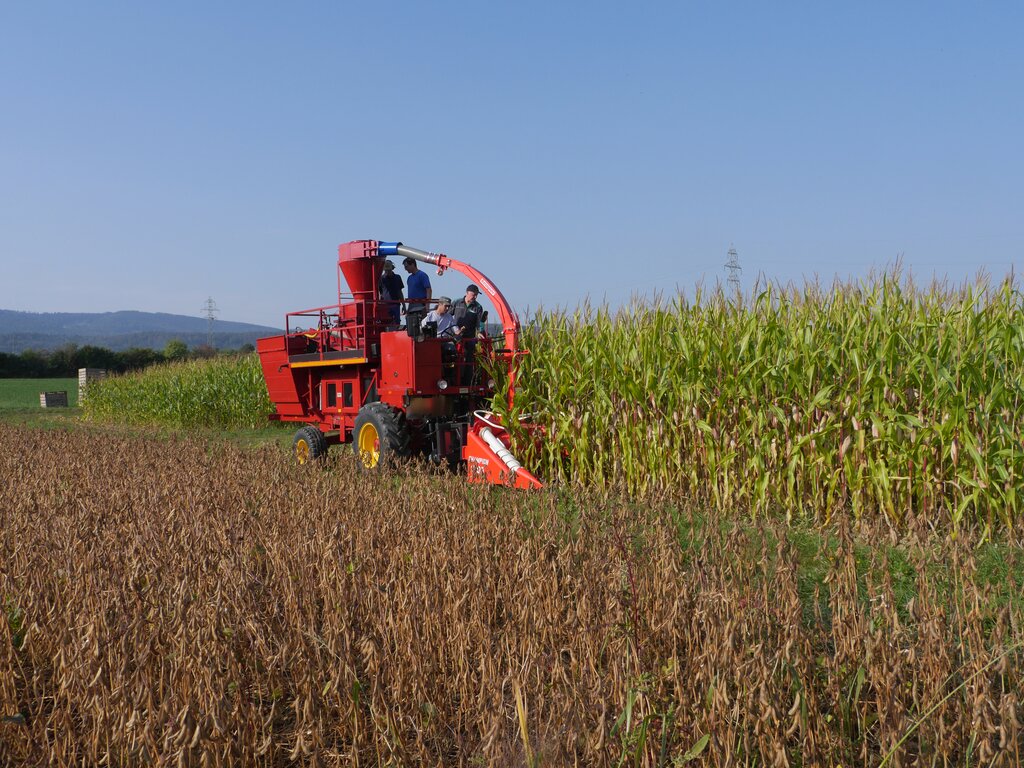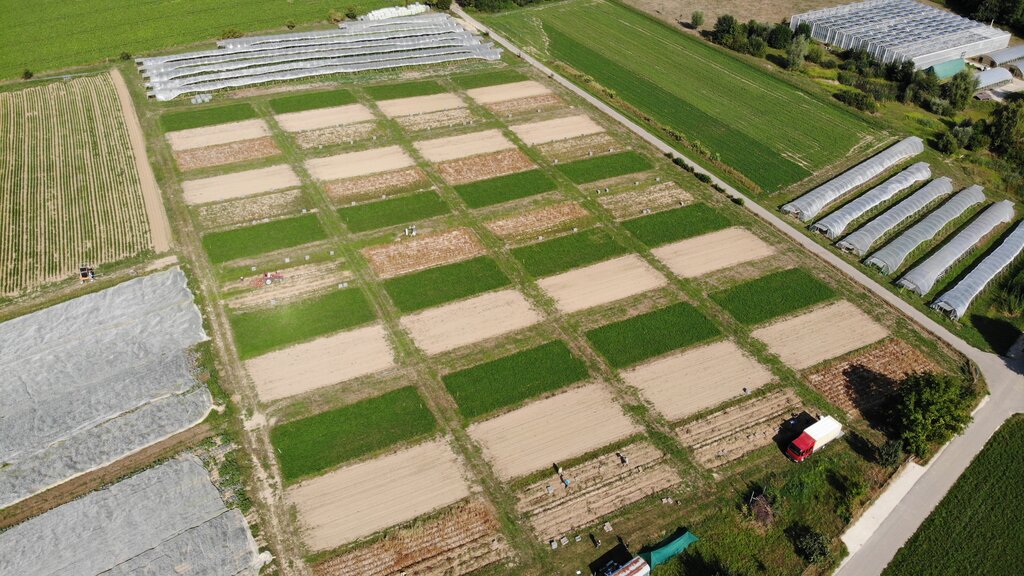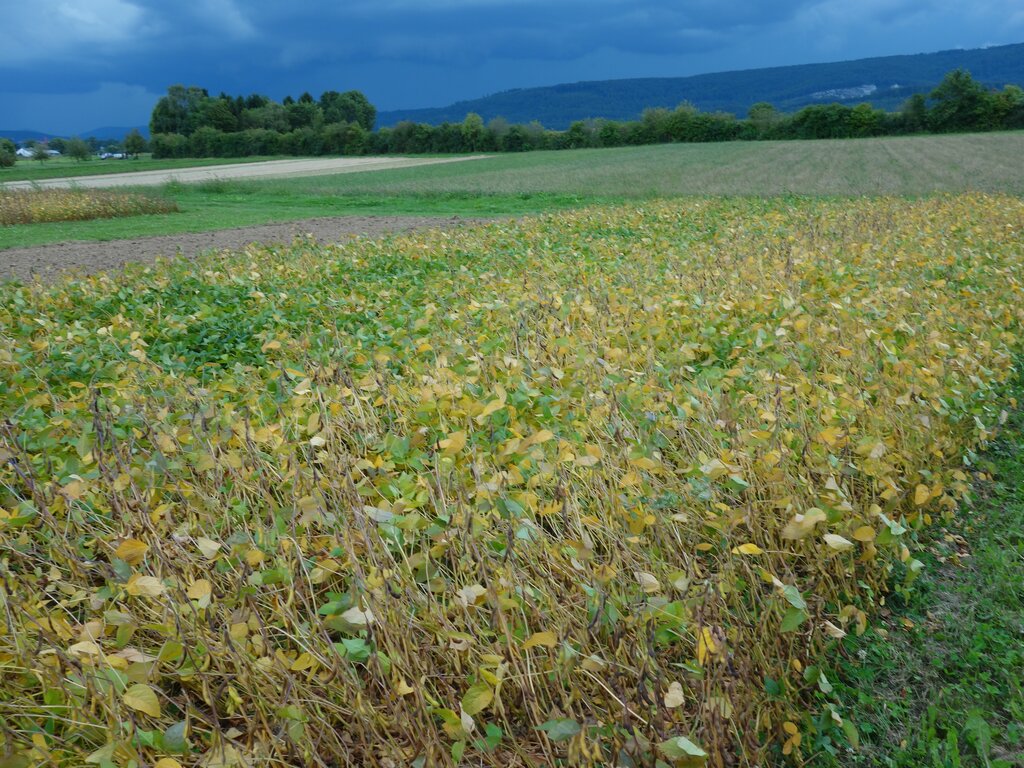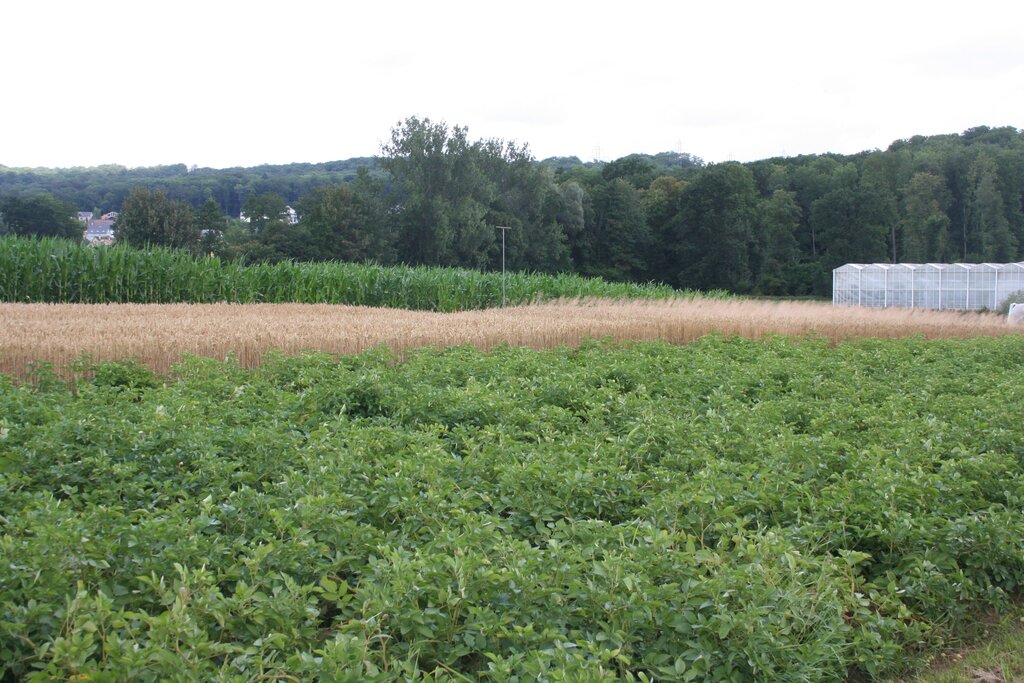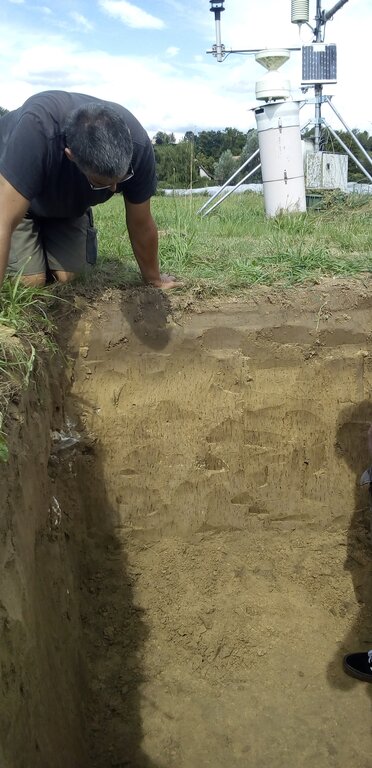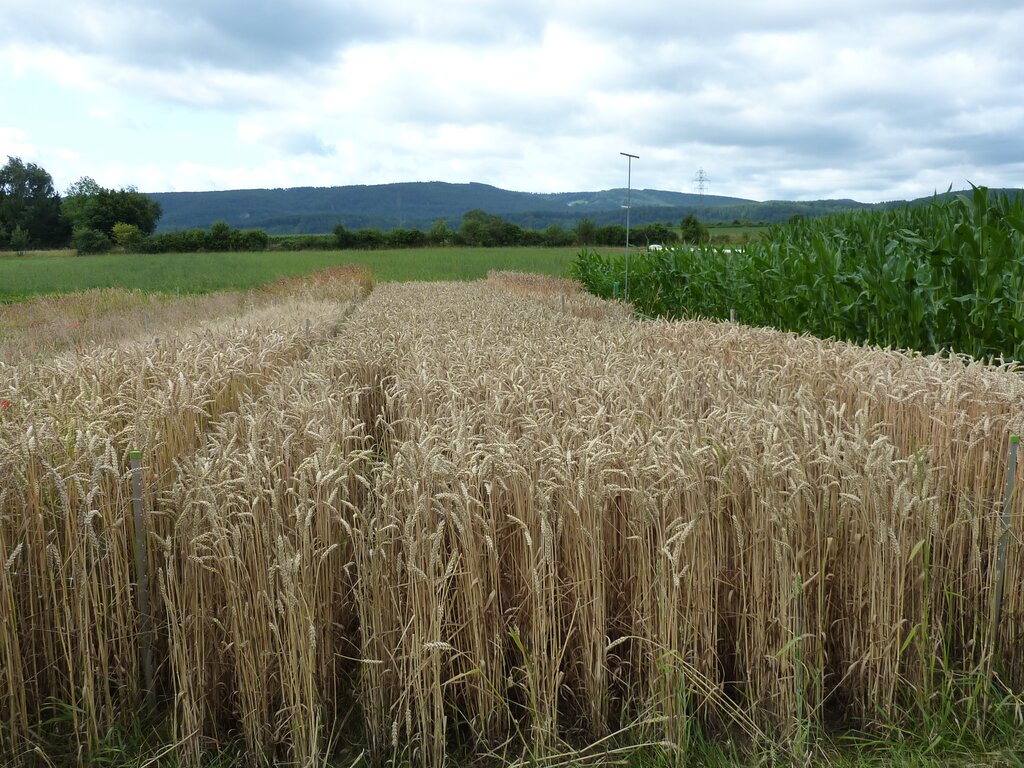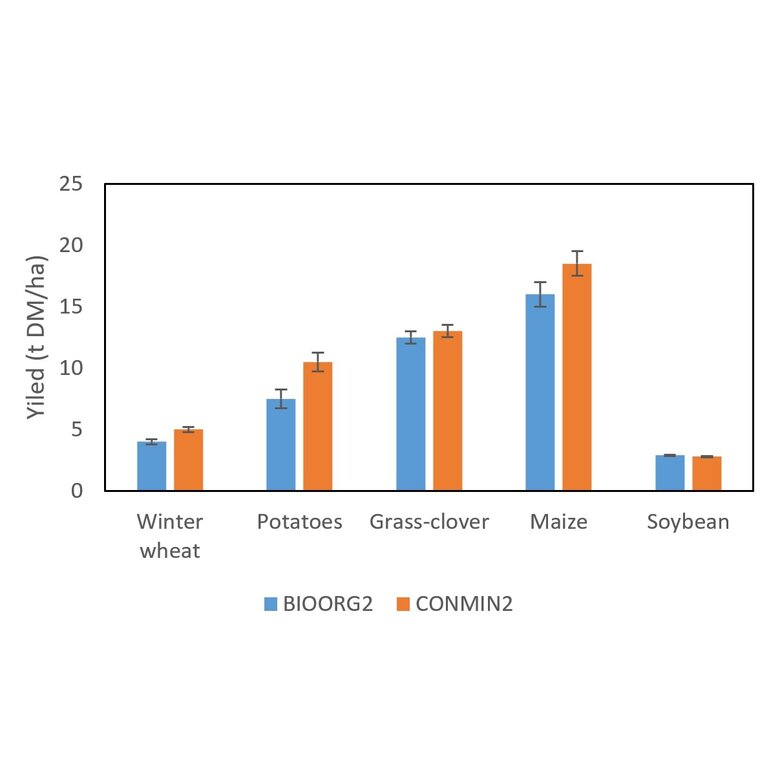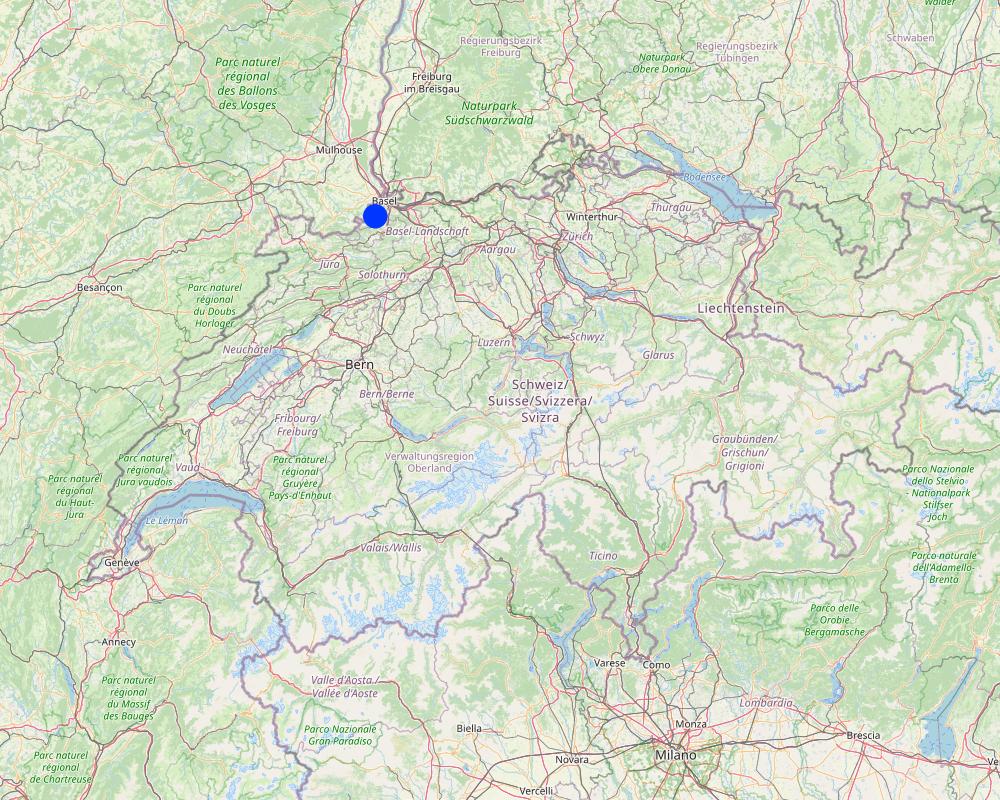Organic Agriculture (DOK Experiment) [Switzerland]
- Creation:
- Update:
- Compiler: Moritz Laub
- Editors: Jochen Mayer, Hans-Martin Krause
- Reviewers: Rima Mekdaschi Studer, William Critchley
Biologischer Landbau/ Biologische Landwirtschaft
technologies_7138 - Switzerland
View sections
Expand all Collapse all1. General information
1.2 Contact details of resource persons and institutions involved in the assessment and documentation of the Technology
SLM specialist:
1.3 Conditions regarding the use of data documented through WOCAT
The compiler and key resource person(s) accept the conditions regarding the use of data documented through WOCAT:
Yes
1.4 Declaration on sustainability of the described Technology
Is the Technology described here problematic with regard to land degradation, so that it cannot be declared a sustainable land management technology?
No
2. Description of the SLM Technology
2.1 Short description of the Technology
Definition of the Technology:
Organic agriculture is a system of crop cultivation that uses biological methods of pest control and organic fertilizer as substitutes for chemical fertilizers and pesticides. It targets sustainability, enhancement of soil fertility, and biological diversity by aiming to close nutrient cycles while generally prohibiting synthetic pesticides, antibiotics, synthetic fertilizers, genetically modified organisms, and growth hormones.
2.2 Detailed description of the Technology
Description:
Organic agriculture is a globally applied technology practiced on agricultural land. It is carried out in 188 countries, with over 96 million hectares of agricultural land managed organically by at least 4.5 million farmers.
The main elements of this technology include the use of biological methods of pest control and organic fertilizer application, which replace chemical fertilizers and pesticides. It generally prohibits synthetic pesticides, antibiotics, synthetic fertilizers, genetically modified organisms, and growth hormones. The purpose of organic agriculture is to achieve sustainability in farming, enhancing soil fertility, increasing biological diversity and reducing the reliance on external inputs to agriculture, relying on nutrient recycling by applying manure and on biological nitrogen fixation from legumes. It also aims to provide a healthier and more environmentally friendly alternative to conventional farming practices. To establish and maintain organic agriculture, major activities include the application of organic fertilizers, crop rotation, and the use of pest-resistant plant varieties. Regular soil testing and monitoring of pest populations are also necessary. Certification of a farm as being officially organic is needed if the products are to be sold at a price premium.
Organic agriculture can improve soil health, reduce pollution of the surrounding environment, and contribute to biodiversity in the fields. Moreover, it can offer healthier food options and potentially higher income for farmers due to the premium prices of organic products. Land users appreciate organic agriculture for its environmental benefits and potential for higher income. However, some dislike the increased labour and time required, the 10-30% of reduction in yields, compared to conventional agriculture, as well as the need for a transition period before farms can be certified as organic and products sold at a premium price.
The DOK experiment presented here is representative of organic practices in the context of temperate regions (specifically, Switzerland and surrounding countries). It is jointly managed by the Research Institute of Organic Agriculture (FiBL), and by the Swiss Confederation's centre of excellence for agricultural research (Agroscope). The name "DOK Experiment" is derived from its main purpose, to compare three cultivation systems: Biodynamic (D), organic (O) and conventional (K) agriculture. These differ in terms of how they are fertilized (D: liquid manure, manure compost, biodynamic preparations; O: liquid manure, rotted manure; K: two variants, one with liquid manure, fresh or rotted manure, mineral fertilizer (CONFYM variant) and one with only mineral fertilizer (CONMIN variant)), as well as by plant protection (D and O: organic; K: chemical-synthetic). In addition to two fertilization levels of the three cultivation systems (half fertilization and standard practice fertilization), two controls are carried out, an unfertilized (N) and a purely mineral-fertilized variant (M). The experiment is spatially replicated four times. The results presented here refer to the conventional (K) and the organic (O) treatments at the standard practice fertilization level.
2.3 Photos of the Technology
2.4 Videos of the Technology
Comments, short description:
DOK-Versuch: Biologische und konventionelle Landwirtschaft im Langzeitvergleich
https://www.youtube.com/watch?v=gDCLHxU0ijg
Date:
16/07/2014
Location:
Therwil
Comments, short description:
Der DOK-Versuch - Eine Internationale Forschungsplattform (Juni 2015)
https://www.youtube.com/watch?v=QYBS4Qj7T14
Date:
16/06/2015
Location:
Therwil
2.5 Country/ region/ locations where the Technology has been applied and which are covered by this assessment
Country:
Switzerland
Region/ State/ Province:
Basel
Further specification of location:
Therwil
Specify the spread of the Technology:
- applied at specific points/ concentrated on a small area
Is/are the technology site(s) located in a permanently protected area?
No
Map
×2.6 Date of implementation
Indicate year of implementation:
1978
2.7 Introduction of the Technology
Specify how the Technology was introduced:
- during experiments/ research
Comments (type of project, etc.):
This is a research site, investigating the benefits of organic agriculture.
3. Classification of the SLM Technology
3.1 Main purpose(s) of the Technology
- reduce, prevent, restore land degradation
- conserve ecosystem
- preserve/ improve biodiversity
- create beneficial social impact
3.2 Current land use type(s) where the Technology is applied
Land use mixed within the same land unit:
No

Cropland
- Annual cropping
Annual cropping - Specify crops:
- cereals - maize
- cereals - wheat (winter)
- fodder crops - clover
- legumes and pulses - soya
- root/tuber crops - potatoes
Annual cropping system:
Wheat or similar rotation with hay/pasture
Number of growing seasons per year:
- 1
Is crop rotation practiced?
Yes
If yes, specify:
The typical crop rotation over the last three cycles was: silage maize, soybean, winter wheat, potato, winter wheat, and two years of grass-clover (Knapp et al. 2023).
3.3 Has land use changed due to the implementation of the Technology?
Has land use changed due to the implementation of the Technology?
- No (Continue with question 3.4)
3.4 Water supply
Water supply for the land on which the Technology is applied:
- rainfed
3.5 SLM group to which the Technology belongs
- rotational systems (crop rotation, fallows, shifting cultivation)
- integrated crop-livestock management
- integrated pest and disease management (incl. organic agriculture)
3.6 SLM measures comprising the Technology

agronomic measures
- A2: Organic matter/ soil fertility
- A5: Seed management, improved varieties
- A6: Residue management
A6: Specify residue management:
A 6.4: retained
Comments:
Comment to A5: It is aimed to use pest-resistant crop varieties, because chemical pesticides are not allowed in organic agriculture.
3.7 Main types of land degradation addressed by the Technology

chemical soil deterioration
- Cn: fertility decline and reduced organic matter content (not caused by erosion)

biological degradation
- Bs: quality and species composition/ diversity decline
- Bl: loss of soil life
3.8 Prevention, reduction, or restoration of land degradation
Specify the goal of the Technology with regard to land degradation:
- prevent land degradation
- reduce land degradation
4. Technical specifications, implementation activities, inputs, and costs
4.1 Technical drawing of the Technology
Technical specifications (related to technical drawing):
A summary of the principles of organic farming in Switzerland
Author:
Moritz Laub
Date:
26/06/2024
4.2 General information regarding the calculation of inputs and costs
Specify how costs and inputs were calculated:
- per Technology area
Indicate size and area unit:
ha
If using a local area unit, indicate conversion factor to one hectare (e.g. 1 ha = 2.47 acres): 1 ha =:
1 ha
other/ national currency (specify):
CHF
If relevant, indicate exchange rate from USD to local currency (e.g. 1 USD = 79.9 Brazilian Real): 1 USD =:
0.91
Indicate average wage cost of hired labour per day:
160-240
4.3 Establishment activities
| Activity | Timing (season) | |
|---|---|---|
| 1. | Courses on the principles of organic farming | Before transition |
| 2. | Transitioning period (already practicing but not yet certified) | 2 years |
| 3. | Certification | Start of year 3 |
Comments:
Detailed information on the transition process and requirements can be found here:
https://www.fibl.org/de/shop/1001-umstellung
4.4 Costs and inputs needed for establishment
Comments:
Courses are needed when transitioning to organic agriculture. They usually take around a week and the cost of courses depends locally.
Further, there are costs for certification, which are usually 400 CHF.
The main costs of transitioning is lost yields in the years during transition, when there is no price premium, yet. Subsidies depend on the Swiss Canton.
Some detailed information on the cost associated with transition can be found here:
https://www.bioaktuell.ch/grundlagen/umstellung/allgemein/kosten-und-beitraege
4.5 Maintenance/ recurrent activities
| Activity | Timing/ frequency | |
|---|---|---|
| 1. | Application of manure | At least yearly |
| 2. | Application of slurry | Usually twice a year |
| 3. | Soil preparation by harrow or cultivator | Yearly |
| 4. | Weed supression by tine weeder | At least yearly |
| 5. | Biological pesticide application (e.g., Novodor) | When needed, mostly in potato |
| 6. | Planting of cover crop | After wheat |
| 7. | Mulching cover crop | Before planting soy/maize |
Comments:
The measures here reflect the activities that are in addition to conventional management needs. Their exact sequence depends on selected crop rotation. In the DOK experiment is was silage maize, soybean, winter wheat, potato, winter wheat, and two years of grass-clover.
4.6 Costs and inputs needed for maintenance/ recurrent activities (per year)
| Specify input | Unit | Quantity | Costs per Unit | Total costs per input | % of costs borne by land users | |
|---|---|---|---|---|---|---|
| Labour | Labour requirements compared to conventional agriculture | % | 113.0 |
Comments:
Because this is a research trial, the detailed costs are neither available nor would they be representative of typical organic farms. Therefore, it is best to rely on the estimated costs from an international study. Based on this study there are 13% higher labour costs in organic farming, but the higher labor cost in organic systems is offset by lower costs of purchased inputs. The total production cost is not different to conventional farming. When the actual organic premiums are considered, gross returns, benefit/cost ratios, and net present values are significantly higher for organic crops compared to conventional crops (21%, 24%, and 35%, respectively).
The study is available here:
https://www.doi.org/10.1073/pnas.1423674112
A good way to estimate the costs of organic vs conventional production is the KTBL Performance Cost calulator. It can be specified to farm and machinery size, soil type and has an option for organic agriculture to see the differences. (only in German language):
https://daten.ktbl.de/dslkrpflanze/postHv.html
4.7 Most important factors affecting the costs
Describe the most determinate factors affecting the costs:
Reduced yield without price premium during transition period.
5. Natural and human environment
5.1 Climate
Annual rainfall
- < 250 mm
- 251-500 mm
- 501-750 mm
- 751-1,000 mm
- 1,001-1,500 mm
- 1,501-2,000 mm
- 2,001-3,000 mm
- 3,001-4,000 mm
- > 4,000 mm
Specify average annual rainfall (if known), in mm:
840.00
Specifications/ comments on rainfall:
Typical temperate climate. Rainfall is mostly evenly distributed throughout the year with slightly higher values in May, June, July and August.
Agro-climatic zone
- humid
5.2 Topography
Slopes on average:
- flat (0-2%)
- gentle (3-5%)
- moderate (6-10%)
- rolling (11-15%)
- hilly (16-30%)
- steep (31-60%)
- very steep (>60%)
Landforms:
- plateau/plains
- ridges
- mountain slopes
- hill slopes
- footslopes
- valley floors
Altitudinal zone:
- 0-100 m a.s.l.
- 101-500 m a.s.l.
- 501-1,000 m a.s.l.
- 1,001-1,500 m a.s.l.
- 1,501-2,000 m a.s.l.
- 2,001-2,500 m a.s.l.
- 2,501-3,000 m a.s.l.
- 3,001-4,000 m a.s.l.
- > 4,000 m a.s.l.
Indicate if the Technology is specifically applied in:
- not relevant
5.3 Soils
Soil depth on average:
- very shallow (0-20 cm)
- shallow (21-50 cm)
- moderately deep (51-80 cm)
- deep (81-120 cm)
- very deep (> 120 cm)
Soil texture (topsoil):
- medium (loamy, silty)
Soil texture (> 20 cm below surface):
- medium (loamy, silty)
Topsoil organic matter:
- medium (1-3%)
5.4 Water availability and quality
Ground water table:
5-50 m
Availability of surface water:
good
Water quality (untreated):
good drinking water
Water quality refers to:
ground water
Is water salinity a problem?
No
Is flooding of the area occurring?
No
5.5 Biodiversity
Species diversity:
- medium
Habitat diversity:
- medium
5.6 Characteristics of land users applying the Technology
Sedentary or nomadic:
- Sedentary
Market orientation of production system:
- commercial/ market
Off-farm income:
- 10-50% of all income
Relative level of wealth:
- average
Individuals or groups:
- individual/ household
Level of mechanization:
- mechanized/ motorized
Gender:
- women
- men
Age of land users:
- middle-aged
5.7 Average area of land used by land users applying the Technology
- < 0.5 ha
- 0.5-1 ha
- 1-2 ha
- 2-5 ha
- 5-15 ha
- 15-50 ha
- 50-100 ha
- 100-500 ha
- 500-1,000 ha
- 1,000-10,000 ha
- > 10,000 ha
Is this considered small-, medium- or large-scale (referring to local context)?
- medium-scale
Comments:
Area refers to typical users (not the DOK Experiment)
5.8 Land ownership, land use rights, and water use rights
Land ownership:
- individual, titled
Land use rights:
- leased
- individual
- irrigation not common
Are land use rights based on a traditional legal system?
No
5.9 Access to services and infrastructure
health:
- poor
- moderate
- good
education:
- poor
- moderate
- good
technical assistance:
- poor
- moderate
- good
employment (e.g. off-farm):
- poor
- moderate
- good
markets:
- poor
- moderate
- good
energy:
- poor
- moderate
- good
roads and transport:
- poor
- moderate
- good
drinking water and sanitation:
- poor
- moderate
- good
financial services:
- poor
- moderate
- good
6. Impacts and concluding statements
6.1 On-site impacts the Technology has shown
Socio-economic impacts
Production
crop production
Quantity before SLM:
Mean wheat yield of 5 t DM/ha
Quantity after SLM:
Mean wheat yield of 4 t DM/ha
Comments/ specify:
Other mean yields of organic treatment (BIOORG2 with 1.4 livestock units):
Potatoes: 7.5 t DM/ha
Soybean: 2.8 t DM/ha
Other mean yields of conventional treatment with only mineral fertilizer(CONMIN2):
Potatoes: 10 t DM/ha
Soybean: 2.8 t DM/ha
fodder production
Quantity before SLM:
Grass-clover: 13 t DM/ha
Quantity after SLM:
Grass-clover: 12.5 t DM/ha
Comments/ specify:
Other mean yields of organic treatment (BIOORG2 with 1.4 livestock units):
Maize silage: 17 t DM/ha
Other mean yields of conventional treatment with only mineral fertilizer(CONMIN2):
Maize silage: 19 t DM/ha
Income and costs
expenses on agricultural inputs
Comments/ specify:
Refers to overall organic agriculture in Switzerland (not DOK experiment)
farm income
Comments/ specify:
Refers to overall organic agriculture in Switzerland (not DOK experiment)
diversity of income sources
Comments/ specify:
Refers to overall organic agriculture in Switzerland (not DOK experiment)
workload
Comments/ specify:
Refers to overall organic agriculture in Switzerland (not DOK experiment)
Ecological impacts
Soil
soil organic matter/ below ground C
Quantity before SLM:
About 1.3% SOC in the mineral fertilizer treatment in 2020
Quantity after SLM:
About 1.6% SOC in the organic agriculture treatment in 2020
Comments/ specify:
Organic treatment refers to BIOORG2 with 1.4 livestock units. Conventional treatment to the one with only mineral fertilizer (CONMIN2).
acidity
Quantity before SLM:
pH of 6.3 in the mineral fertilizer treatment in 2020
Quantity after SLM:
pH of 6.5 in the organic agriculture treatment in 2020
Comments/ specify:
Organic treatment refers to BIOORG2 with 1.4 livestock units. Conventional treatment to the one with only mineral fertilizer (CONMIN2).
Specify assessment of on-site impacts (measurements):
All presented results are from published studies about the DOK experiment.
6.2 Off-site impacts the Technology has shown
groundwater/ river pollution
Greenhouse gas emissions per land area
Comments/ specify:
Based on a recent modeling study, emissions were between 0.5 to 1 t CO2 equivalent less per ha and year in organic compared to conventional agriculture in Switzerland (https://doi.org/10.1016/j.agsy.2020.102822).
Greenhouse gas emissions per calorie
Comments/ specify:
In contrast to emissions per land area, it has been found that due to the lower yields there is little difference in terms of emissions per unit of food produced (https://doi.org/10.1088/1748-9326/aa6cd5).
Specify assessment of off-site impacts (measurements):
There are ongoing debates on whether organic agriculture really leads to lower emissions than conventional agriculture, and the conclusion largely depends on the unit of reference (amount of food vs. per ha).
6.3 Exposure and sensitivity of the Technology to gradual climate change and climate-related extremes/ disasters (as perceived by land users)
Gradual climate change
Gradual climate change
| Season | increase or decrease | How does the Technology cope with it? | |
|---|---|---|---|
| annual temperature | increase | well | |
| seasonal rainfall | summer | decrease | well |
Climate-related extremes (disasters)
Climatological disasters
| How does the Technology cope with it? | |
|---|---|
| drought | moderately |
Comments:
Preliminary results from rain-emission shelters indicates similar resilience of the organic agriculture treatment as the conventional ones to drought.
However, organic agriculture in general is expected to better cope with climate change than conventional agriculture (https://www.fibl.org/fileadmin/documents/shop/1500-climate-change.pdf)
6.4 Cost-benefit analysis
How do the benefits compare with the establishment costs (from land users’ perspective)?
Short-term returns:
negative
Long-term returns:
positive
How do the benefits compare with the maintenance/ recurrent costs (from land users' perspective)?
Short-term returns:
slightly positive
Long-term returns:
slightly positive
Comments:
The main establishment costs is that in the first years of establishment, farmers have to apply all organic principles and thus have lower yields. However, certification as organic produce, which receive price premiums, is only possible 1-3 years after establishment, depending on the farm type. Thus, there is a period in which the lower yields are not yet compensated by a price premium. Once the system is certified and a price premium received, gross returns, benefit/cost ratios, and net present values are significantly higher for organic crops compared to conventional crops (https://www.doi.org/10.1073/pnas.1423674112)
6.5 Adoption of the Technology
- 11-50%
If available, quantify (no. of households and/ or area covered):
About 16% of all farms in Switzerland are currently organic. (BAFU; https://www.bfs.admin.ch/news/de/2024-0392)
Of all those who have adopted the Technology, how many did so spontaneously, i.e. without receiving any material incentives/ payments?
- 51-90%
Comments:
Switzerland has specific subsidies for those that practice organic farming but also many subsidies that all farmers receive. It is thus not 100% clear how many farmers were mainly incentivized by the additional subsidies. However, most become organic farmers out of conviction that it is the better and more sustainable farming system.
6.6 Adaptation
Has the Technology been modified recently to adapt to changing conditions?
No
6.7 Strengths/ advantages/ opportunities of the Technology
| Strengths/ advantages/ opportunities in the land user’s view |
|---|
| Higher income due to price premiums |
| Less dependance on external inputs |
| Strengths/ advantages/ opportunities in the compiler’s or other key resource person’s view |
|---|
| Better nutrient cycling and soil fertility. |
6.8 Weaknesses/ disadvantages/ risks of the Technology and ways of overcoming them
| Weaknesses/ disadvantages/ risks in the compiler’s or other key resource person’s view | How can they be overcome? |
|---|---|
| Lower yields compared to conventional agriculture. | Price premium. Eating less meat, which consumes most of the agricultural produce. |
7. References and links
7.1 Methods/ sources of information
- interviews with SLM specialists/ experts
6
- compilation from reports and other existing documentation
When were the data compiled (in the field)?
27/02/2019
Comments:
Date of most recent soil sampling
7.2 References to available publications
Title, author, year, ISBN:
Knapp, S., Gunst, L., Mäder, P., Ghiasi, S., Mayer, J., 2023. Organic cropping systems maintain yields but have lower yield levels and yield stability than conventional systems – Results from the DOK trial in Switzerland. Field Crops Research 302, 109072.
Available from where? Costs?
For free: https://doi.org/10.1016/j.fcr.2023.109072
Title, author, year, ISBN:
Krause, H.-M., Stehle, B., Mayer, J., Mayer, M., Steffens, M., Mäder, P., Fliessbach, A., 2022. Biological soil quality and soil organic carbon change in biodynamic, organic, and conventional farming systems after 42 years. Agron. Sustain. Dev. 42, 117.
Available from where? Costs?
For free: https://doi.org/10.1007/s13593-022-00843-y
Title, author, year, ISBN:
Mayer, M., Krause, H.-M., Fliessbach, A., Mäder, P., Steffens, M., 2022. Fertilizer quality and labile soil organic matter fractions are vital for organic carbon sequestration in temperate arable soils within a long-term trial in Switzerland. Geoderma 426, 116080.
Available from where? Costs?
For free: https://doi.org/10.1016/j.geoderma.2022.116080
Title, author, year, ISBN:
Crowder, D.W., Reganold, J.P., 2015. Financial competitiveness of organic agriculture on a global scale. Proceedings of the National Academy of Sciences 112, 7611–7616.
Available from where? Costs?
For free: https://doi.org/10.1073/pnas.1423674112
7.3 Links to relevant online information
Title/ description:
FIBL Webpage DOK trials
URL:
https://www.fibl.org/en/themes/projectdatabase/projectitem/project/404
7.4 General comments
Costs are the most difficult to estimate from agricultural experiments (not real field conditions)
Links and modules
Expand all Collapse allLinks
No links
Modules
No modules


